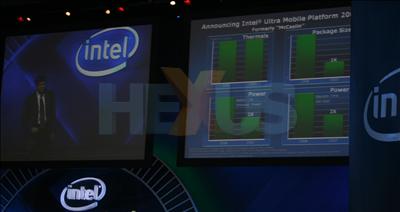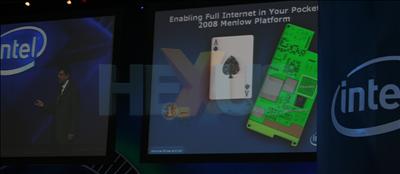
Intel's Anand Chandrasekhar commented that the growing richness of content on the internet is driving innovation for mobile devices. There's a real need to display more immersive content and present mobile solutions simply aren't cutting it.
Chandrasekhar further commented that mobile phones weren't well-designed to process and display the increasing demands placed by the proliferation of video streaming and multifarious A/V formats present on the 'net, and most notebooks were too large to be truly portable. Rather, he said, mobile internet would be best leveraged by advances in ultra-mobile PC (UMPC) technology based on Intel hardware. Apple might disagree and put the iPhone forward as the perfect device, though.
Creating the perfect UMPC, then, requires a high-performance, low-power hardware solution that's able to scale with future processing demands whilst paying close attention to battery life considerations, according to Anand.
 Click for larger image
Click for larger imageIn view of this, Intel is officially launching its new ultra-mobile platform for 2007, although we've known about the proposed architecture for a while. It seems as if XScale's time is numbered in the UMPC space.
 Click for larger image
Click for larger imageThe platform formerly known as McCaslin marries either Intel's Stealey A100 and A110 CPUs (12W TDP, Pentium M-derived, single-core, 90nm) to a 945GU chipset featuring the ICH7U southbridge. That's old-hat technology, frankly, that's been rehashed to fill in a gap in the market, in our opinion. Inferring a little, we expect the battery life to be poor on a mid-sized device.
We expect that Intel's UMPC partners will also add WiMAX and GPS-based connectivity. VIA, currently plying the market with its C7M CPU, will have some serious competition in the UMPC market soon, and expect to see many more sexy-looking McCaslin-based UMPC devices to ship in H2 this year. Samsung's McCaslin-based UMPC - the Q1 Ultra - should be available imminently. We just hope they're not priced too high.
 Click for larger image
Click for larger image Click for larger image
Click for larger imageLooking further afield, Intel will be introducing the Menlow platform, designed from the ground up, to succeed McCaslin. Based on a 45nm manufacturing process, the UMPC-oriented Silverthorne CPU (and associated chipset) is set to cut power requirements significantly further. Anand demonstrated a prototype Menlow UMPC, manufactured by Compal, downloading and running an Intel Flash-based video from YouTube.













